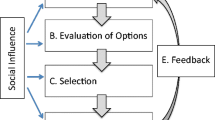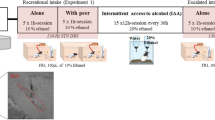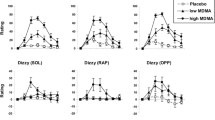Abstract
Rationale
Stimulant use, including cocaine, often occurs in a social context whose influence is important to understand to decrease intake and reduce associated harms. Although the importance of social influence in the context of drug addiction is known, there is a need for studies assessing its neurobiological substrate and for translational research.
Objectives
Here, we explored the influence of peer presence and familiarity on cocaine intake and its neurobiological basis. Given the regulatory role of the subthalamic nucleus (STN) on cocaine intake and emotions, we investigated its role on such influence of social context on cocaine intake.
Methods
We first compared cocaine consumption in various conditions (with no peer present or with peers with different characteristics: abstinent peer or drug-taking peer, familiar or not, cocaine-naive or not, dominant or subordinate) in rats (n = 90). Then, with a translational approach, we assessed the influence of the social context (alone, in the group, in a dyad with familiar or non-familiar peers) on drug intake in human drug users (n = 77).
Results
The drug consumption was reduced when a peer was present, abstinent, or drug-taking as well, and further diminished when the peer was non-familiar. The presence of a non-familiar and drug-naive peer represents key conditions to diminish cocaine intake. The STN lesion by itself reduced cocaine intake to the level reached in presence of a non-familiar naive peer and affected social cognition, positioning the STN as one neurobiological substrate of social influence on drug intake. Then, the human study confirmed the beneficial effect of social presence, especially of non-familiar peers.
Conclusion
Our results indirectly support the use of social interventions and harm reduction strategies and position the STN as a key cerebral structure to mediate these effects.





Similar content being viewed by others
Change history
12 April 2023
A Correction to this paper has been published: https://doi.org/10.1007/s00213-023-06364-0
References
Albin RL, Young AB, Penney JB (1989) The functional anatomy of basal ganglia disorders. Trends Neurosci 12(10):366–375. https://doi.org/10.1016/0166-2236(89)90074-X
Aloise-Young PA, Kaeppner CJ (2005) Sociometric status as a predictor of onset and progression in adolescent cigarette smoking. Nicotine Tob Res 7(2):199–206. https://doi.org/10.1080/14622200500055277
Barnes GM, Reifman AS, Farrell MP, Dintcheff BA (2000) The effects of parenting on the development of adolescent alcohol misuse: a six-wave latent growth model. J Marriage Fam 62(1):175–186
Barnett SA (1967) Rats. Sci Am 216(1):78–85. https://doi.org/10.1038/scientificamerican0167-78
Baron RS (1986) Distraction-conflict theory: progress and problems. Adv Exp Soc Psychol 19:1–40. https://doi.org/10.1016/S0065-2601(08)60211-7
Baunez C, Amalric M, Robbins TW (2002) Enhanced food-related motivation after bilateral lesions of the subthalamic nucleus. J Neurosci 22(2):562–568
Baunez C, Dias C, Cador M, Amalric M (2005) The subthalamic nucleus exerts opposite control on cocaine and ‘natural’ rewards. Nat Neurosc 8(4):484–489. https://doi.org/10.1038/nn1429
Berry MS, Johnson MW (2018) Does being drunk or high cause HIV sexual risk behavior? a systematic review of drug administration studies. Pharmacol Biochem Behav 164:125–138. https://doi.org/10.1016/j.pbb.2017.08.009
Brewer DD, Catalano RF, Haggerty K, Gainey RR, Fleming CB (1998) A meta-analysis of predictors of continued drug use during and after treatment for opiate addiction. Addiction (Abingdon, England) 93(1):73–92
Buchanan AS, Latkin CA (2008) Drug use in the social networks of heroin and cocaine users before and after drug cessation. Drug Alcohol Depend 96(3):286–289. https://doi.org/10.1016/j.drugalcdep.2008.03.008
Buot A, Welter M-L, Karachi C, Pochon J-B, Bardinet E, Yelnik J, Mallet L (2013) Processing of emotional information in the human subthalamic nucleus. J Neurol Neurosurg Psychiatry 84(12):1331–1339. https://doi.org/10.1136/jnnp-2011-302158
Burke AR, Miczek KA (2014) Stress in adolescence and drugs of abuse in rodent models: role of dopamine, CRF, and HPA axis. Psychopharmacology 231(8):1557–1580. https://doi.org/10.1007/s00213-013-3369-1
Bush et al (1998) The AUDIT alcohol consumption questions (AUDIT-C): an effective brief screening test for problem drinking. Ambulatory Care Quality Improvement Project (ACQUIP). Alcohol Use Disorders Identification Test. Arch Intern Med 158(16):1789–1795. https://doi.org/10.1001/archinte.158.16.1789
Caprioli D, Celentano M, Dubla A, Lucantonio F, Nencini P, Badiani A (2009) Ambience and drug choice: cocaine- and heroin-taking as a function of environmental context in humans and rats. Biol Psychiatry 65(10):893–899. https://doi.org/10.1016/j.biopsych.2008.12.009
Dorius CJ, Bahr SJ, Hoffmann JP, Harmon EL (2004) Parenting practices as moderators of the relationship between peers and adolescent marijuana use. J Marriage Fam 66(1):163–178. https://doi.org/10.1111/j.0022-2445.2004.00011.x-i1
Engelmann M, Wotjak CT, Landgraf R (1995) Social discrimination procedure: an alternative method to investigate juvenile recognition abilities in rats. Physiol Behav 58(2):315–321. https://doi.org/10.1016/0031-9384(95)00053-L
Fritz M, El Rawas R, Salti A, Klement S, Bardo MT, Kemmler G, Dechant G, Saria A, Zernig G (2011a) Reversal of Cocaine-conditioned place preference and mesocorticolimbic Zif268 expression by social interaction in rats: reversal of cocaine-conditioned place preference. Addict Biol 16(2):273–284. https://doi.org/10.1111/j.1369-1600.2010.00285.x
Fritz M, El Rawas R, Klement S, Kummer K, Mayr MJ, Eggart V, Salti A, Bardo MT, Saria A, Zernig G (2011b) Differential effects of accumbens core vs. shell lesions in a rat concurrent conditioned place preference paradigm for cocaine vs social interaction. Edited by Antonio Verdejo García. PLoS ONE 6(10):e26761. https://doi.org/10.1371/journal.pone.0026761
Furnari M, Epstein DH, Phillips KA, Jobes ML, Kowalczyk WJ, Vahabzadeh M, Lin J-L, Preston KL (2015) Some of the people, some of the time: field evidence for associations and dissociations between stress and drug use. Psychopharmacology 232(19):3529–3537. https://doi.org/10.1007/s00213-015-3998-7
Gipson CD, Yates JR, Beckmann JS, Marusich JA, Zentall TR, Bardo MT (2011) Social facilitation of D-amphetamine self-administration in rats. Exp Clin Psychopharmacol 19(6):409–419. https://doi.org/10.1037/a0024682
Gyarmathy VA, Li N, Tobin KE, Hoffman IF, Sokolov N, Levchenko J, Batluk J, Kozlov AA, Kozlov AP, Latkin CA (2010) Injecting equipment sharing in Russian drug injecting dyads. AIDS Behav 14(1):141–151. https://doi.org/10.1007/s10461-008-9518-6
Heilig M, Epstein DH, Nader MA, Shaham Y (2016) Time to connect: bringing social context into addiction neuroscience. Nat Rev Neurosci 17(9):592–599. https://doi.org/10.1038/nrn.2016.67
Hughes RN (1968) Behaviour of male and female rats with free choice of two environments differing in novelty. Anim Behav 16(1):92–96. https://doi.org/10.1016/0003-3472(68)90116-4
Huguet P, Barbet I, Belletier C, Monteil J-M, Fagot J (2014) Cognitive control under social influence in baboons. J Exp Psychol Gen 143(6):2067–2073. https://doi.org/10.1037/xge0000026
Jacobs S, Tsien JZ (2017) Adult forebrain NMDA receptors gate social motivation and social memory. Neurobiol Learn Mem, MCCS 2017, 138 (February):164–72. https://doi.org/10.1016/j.nlm.2016.08.019
Kalampokini S, Lyros E, Lochner P, Fassbender K, Unger MM (2020) Effects of subthalamic nucleus deep brain stimulation on facial emotion recognition in Parkinson’s Disease: a critical literature review. Behav Neurol 2020(July):1–18. https://doi.org/10.1155/2020/4329297
Kandel D (1973) Adolescent marihuana use: role of parents and peers. Science 181(4104):1067–1070. https://doi.org/10.1126/science.181.4104.1067
Kandel DB (1980) Drug and drinking behavior among youth. Ann Rev Sociol 6(1):235–285. https://doi.org/10.1146/annurev.so.06.080180.001315
Kandel DB (1985) On processes of peer influences in adolescent drug use: a developmental perspective. Adv Alcohol Subst Abuse 4(3–4):139–162. https://doi.org/10.1300/J251v04n03_07
Kandel ER, Kandel DB (2014) A molecular basis for nicotine as a gateway drug. N Engl J Med 371(10):932–943. https://doi.org/10.1056/NEJMsa1405092
Latkin C, Mandell W, Vlahov D, Oziemkowska M, Celentano D (1996) People and places: behavioral settings and personal network characteristics as correlates of needle sharing. J Acquir Immune Defic Syndr Hum Retrovirol 13(3):273–280
Latkin CA, Knowlton AR, Hoover D, Mandell W (1999) Drug network characteristics as a predictor of cessation of drug use among adult injection drug users: a prospective study. Am J Drug Alcohol Abuse 25(3):463–473
Liang K-Y, Zeger SL (1986) Longitudinal Data analysis using generalized linear models. Biometrika 73(1):13–22. https://doi.org/10.1093/biomet/73.1.13
Linas BS, Latkin C, Westergaard RP, Chang LW, Bollinger RC, Genz A, Kirk GD (2015) Capturing illicit drug use where and when it happens: an ecological momentary assessment of the social, physical and activity environment of using versus craving illicit drugs. Addiction 110(2):315–325. https://doi.org/10.1111/add.12768
Maldonado AM, Finkbeiner LM, Kirstein CL (2008) Social interaction and partner familiarity differentially alter voluntary ethanol intake in adolescent male and female rats. Alcohol 42(8):641–648. https://doi.org/10.1016/j.alcohol.2008.08.003
Martins SS, Sampson L, Cerdá M, Galea S (2015) Worldwide prevalence and trends in unintentional drug overdose: a systematic review of the literature. Am J Public Health 105(11):e29-49. https://doi.org/10.2105/AJPH.2015.302843
Miczek K, Yap J, Covingtoniii H (2008) Social stress, therapeutics and drug abuse: preclinical models of escalated and depressed intake. Pharmacol Ther 120(2):102–128. https://doi.org/10.1016/j.pharmthera.2008.07.006
Mohr CD, Arpin S, McCabe CT (2015) Daily affect variability and context-specific alcohol consumption. Drug Alcohol Rev 34(6):581–587. https://doi.org/10.1111/dar.12253
Monfardini E, Redouté J, Hadj-Bouziane F, Hynaux C, Fradin J, Huguet P, Costes N, Meunier M (2016) Others’ sheer presence boosts brain activity in the attention (But Not the Motivation) Network. Cereb Cortex 26(6):2427–39. https://doi.org/10.1093/cercor/bhv067
Montanari C, Giorla E, Pelloux Y, Baunez C (2020) Subthalamic Nucleus mediates the modulation on cocaine self-administration induced by ultrasonic vocalization playback in rats. Addict Biol 25(1):1–10, e12710. https://doi.org/10.1111/adb.12710
Moy SS, Nadler JJ, Perez A, Barbaro RP, Johns JM, Magnuson TR, Piven J, Crawley JN (2004) Sociability and preference for social novelty in five inbred strains: an approach to assess autistic-like behavior in mice. Genes Brain Behav 3(5):287–302. https://doi.org/10.1111/j.1601-1848.2004.00076.x
Nader J, Claudia C, El Rawas R, Favot L, Jaber M, Thiriet N, Solinas M (2012) Loss of environmental enrichment increases vulnerability to cocaine addiction. Neuropsychopharmacology 37(7):1579–1587
Neaigus A, Gyarmathy VA, Miller M, Frajzyngier VM, Friedman SR, Des Jarlais DC (2006) Transitions to injecting drug use among noninjecting heroin users. J Acquir Immune Defic Syndr 41(4):493–503. https://doi.org/10.1097/01.qai.0000186391.49205.3b
Pandina RJ, Labouvie EW, Johnson V, White HR (1990) The relationship between alcohol and marijuana use and competence in adolescence. J Health Soc Policy 1(3):89–108. https://doi.org/10.1300/J045v01n03_06
Peitz GW, Strickland JC, Pitts EG, Foley M, Tonidandel S, Smith MA (2013) Peer influences on drug self-administration: an econometric analysis in socially housed rats. Behav Pharmacol 24(2):114–123. https://doi.org/10.1097/FBP.0b013e32835f1719
Pelloux Y, Baunez C (2017) Targeting the subthalamic nucleus in a preclinical model of alcohol use disorder. Psychopharmacology 234(14):2127–2137. https://doi.org/10.1007/s00213-017-4618-5
Pelloux Y, Degoulet M, Tiran-Cappello A, Cohen C, Lardeux S, George O, Koob GF, Ahmed SH, Baunez C (2018) Subthalamic nucleus high frequency stimulation prevents and reverses escalated cocaine use. Mol Psychiatry 23(12):2266–2276. https://doi.org/10.1038/s41380-018-0080-y
Pelloux Y, Giorla E, Montanari C, Baunez C (2019) Social modulation of drug use and drug addiction. Neuropharmacology 159(November):107545. https://doi.org/10.1016/j.neuropharm.2019.02.027
Pelloux Y, Meffre J, Giorla E, Baunez C (2014) The subthalamic nucleus keeps you high on emotion: behavioral consequences of its inactivation. Front Behav Neurosci 8(December):414. https://doi.org/10.3389/fnbeh.2014.00414
Péron J, Grandjean D, Le Jeune F, Sauleau P, Haegelen C, Drapier D, Rouaud T, Drapier S, Vérin M (2010) Recognition of emotional prosody is altered after subthalamic nucleus deep brain stimulation in Parkinson’s Disease. Neuropsychologia 48(4):1053–1062. https://doi.org/10.1016/j.neuropsychologia.2009.12.003
Péron J, Cekic S, Haegelen C, Sauleau P, Patel S, Drapier D, Vérin M, Grandjean D (2015) Sensory contribution to vocal emotion deficit in Parkinson’s Disease after subthalamic stimulation. Cortex 63(February):172–183. https://doi.org/10.1016/j.cortex.2014.08.023
Preston KL, Kowalczyk WJ, Phillips KA, Jobes ML, Vahabzadeh M, Lin J-L, Mezghanni M, Epstein DH (2017) Context and craving during stressful events in the daily lives of drug-dependent patients. Psychopharmacology 234(17):2631–2642. https://doi.org/10.1007/s00213-017-4663-0
Rouaud T, Lardeux S, Panayotis N, Paleressompoulle D, Cador M, Baunez C (2010) Reducing the desire for cocaine with subthalamic nucleus deep brain stimulation. Proc Natl Acad Sci 107:1196–1200. https://doi.org/10.1073/pnas.0908189107
Rusby JC, Forrester KK, Biglan A, Metzler CW (2005) Relationships between peer harassment and adolescent problem behaviors. J Early Adolesc 25(4):453–477. https://doi.org/10.1177/0272431605279837
Scheier LM, Botvin GJ, Diaz T, Griffin KW (1999) Social skills, competence, and drug refusal efficacy as predictors of adolescent alcohol use. J Drug Educ 29(3):251–278. https://doi.org/10.2190/M3CT-WWJM-5JAQ-WP15
Schroeder JR, Latkin CA, Hoover DR, Curry AD, Knowlton AR, Celentano DD (2001) Illicit drug use in one’s social network and in one’s neighborhood predicts individual heroin and cocaine use. Ann Epidemiol 11(6):389–394
Schweinfurth MK (2020) The social life of Norway rats (Rattus Norvegicus). eLife 9(April):e54020. https://doi.org/10.7554/eLife.54020
Shadur JM, Hussong AM, Haroon M (2015) Negative affect variability and adolescent self-medication: the role of the peer context. Drug Alcohol Rev 34(6):571–580. https://doi.org/10.1111/dar.12260
Sherman SG, Latkin CA (2001) Intimate relationship characteristics associated with condom use among drug users and their sex partners: a multilevel analysis. Drug Alcohol Depend 64(1):97–104. https://doi.org/10.1016/S0376-8716(00)00236-2
Smith MA (2012) Peer influences on drug self-administration: social facilitation and social inhibition of cocaine intake in male rats. Psychopharmacology 224(1):81–90. https://doi.org/10.1007/s00213-012-2737-6
Smith MA, Lacy RT, Strickland JC (2014) The effects of social learning on the acquisition of cocaine self-administration. Drug Alcohol Depend 141(August):1–8. https://doi.org/10.1016/j.drugalcdep.2014.04.025
Solinas M, Thiriet N, El Rawas R, Lardeux V, Jaber M (2009) Environmental enrichment during early stages of life reduces the behavioral, neurochemical, and molecular effects of cocaine. Neuropsychopharmacology 34(5):1102–1111. https://doi.org/10.1038/npp.2008.51
Sordo L, Indave BI, Barrio G, Degenhardt L, de la Fuente L, Bravo MJ (2014) Cocaine use and risk of stroke: a systematic review. Drug Alcohol Depend 142(September):1–13. https://doi.org/10.1016/j.drugalcdep.2014.06.041
Stairs DJ, Bardo MT (2009) Neurobehavioral effects of environmental enrichment and drug abuse vulnerability. Pharmacol Biochem Behav 92(3):377–382. https://doi.org/10.1016/j.pbb.2009.01.016
Strickland JC, Smith MA (2014) The effects of social contact on drug use: behavioral mechanisms controlling drug intake. Exp Clin Psychopharmacol 22(1):23–34. https://doi.org/10.1037/a0034669
Thiel KJ, Sanabria F, Neisewander JL (2009) Synergistic interaction between nicotine and social rewards in adolescent male rats. Psychopharmacology 204(3):391–402. https://doi.org/10.1007/s00213-009-1470-2
Thor DH, Holloway WR (1982) Social memory of the male laboratory rat. J Comp Physiol Psychol 96(6):1000–1006. https://doi.org/10.1037/0735-7036.96.6.1000
Tomie A, Burger KM, Di Poce J, Pohorecky LA (2004) Social opportunity and ethanol drinking in rats. Prog Neuropsychopharmacol Biol Psychiatry 28(7):1089–1097. https://doi.org/10.1016/j.pnpbp.2004.05.044
Venniro M, Zhang M, Caprioli D, Hoots JK, Golden SA, Heins C, Morales M, Epstein DH, Shaham Y (2018) Volitional social interaction prevents drug addiction in rat models. Nat Neurosci 21(11):1520–1529. https://doi.org/10.1038/s41593-018-0246-6
Weiss VG, Yates JR, Beckmann JS, Hammerslag LR, Bardo MT (2018) Social reinstatement: a rat model of peer-induced relapse. Psychopharmacology 235(12):3391–3400. https://doi.org/10.1007/s00213-018-5048-8
Wu ZH, Eschbach K, Grady JJ (2008) Contextual Influences on polydrug use among young, low-income women: effects of neighborhood and personal networks. Am J Addict 17(2):135–144. https://doi.org/10.1080/10550490701863025
Acknowledgements
Our thanks to Dany Palleressompoulle and Joel Baurberg for their technical support, as well as to the animal facilities’ personnel. Our thanks also to Silvia Rosellini and Chiara Calzolaio for help with statistical analyses and to Jude Sweeney and Maya Williams for the English revisions and editing of the manuscript.
Funding
This research was funded by CNRS, Aix-Marseille Université (AMU), the “Agence Nationale pour la Recherche” (ANR_2010-NEUR-005–01 in the framework of the ERA-Net NEURON to C.B. and supporting Y.P.), the “Fondation pour la Recherche Médicale” (FRM DPA20140629789 to C.B.), and the support of the A*MIDEX project (ANR-11-IDEX-0001–02) funded by the “Investissements d’Avenir” French Government program, managed by the French National Research Agency (ANR).
Author information
Authors and Affiliations
Contributions
E.G and C.V conducted most of the rats’ experiments, with the help of L.G and C.M; S.N and PR conducted the human experiments; C.B, C.V, E.G, P.C, and S.N wrote the paper; A.V, C.P, C.V, E.G, S.N, and P.R conducted the statistical analysis; C.M, C.V, and E.G conducted the histological analysis; C.B, C.V, E.G, K.D, P.H, and Y.P designed the rat experiment; CB, PR, PC, and SN designed the human questionnaire; CB, PC, and PH obtained the funding from A*MIDEX.
Corresponding author
Ethics declarations
Conflict of interest
The authors declare no competing interests.
Additional information
Publisher's note
Springer Nature remains neutral with regard to jurisdictional claims in published maps and institutional affiliations.
This article belongs to a Special Issue on Nature vs. Nurture in Addiction Research
The original version of this article was revised: This article was originally published with the given names of all the authors set in initial letters.
Supplementary Information
Below is the link to the electronic supplementary material.
Rights and permissions
Springer Nature or its licensor (e.g. a society or other partner) holds exclusive rights to this article under a publishing agreement with the author(s) or other rightsholder(s); author self-archiving of the accepted manuscript version of this article is solely governed by the terms of such publishing agreement and applicable law.
About this article
Cite this article
Giorla, E., Nordmann, S., Vielle, C. et al. Peer presence and familiarity as key factors to reduce cocaine intake in both rats and humans: an effect mediated by the subthalamic nucleus. Psychopharmacology 239, 1097–1113 (2022). https://doi.org/10.1007/s00213-021-06033-0
Received:
Accepted:
Published:
Issue Date:
DOI: https://doi.org/10.1007/s00213-021-06033-0




